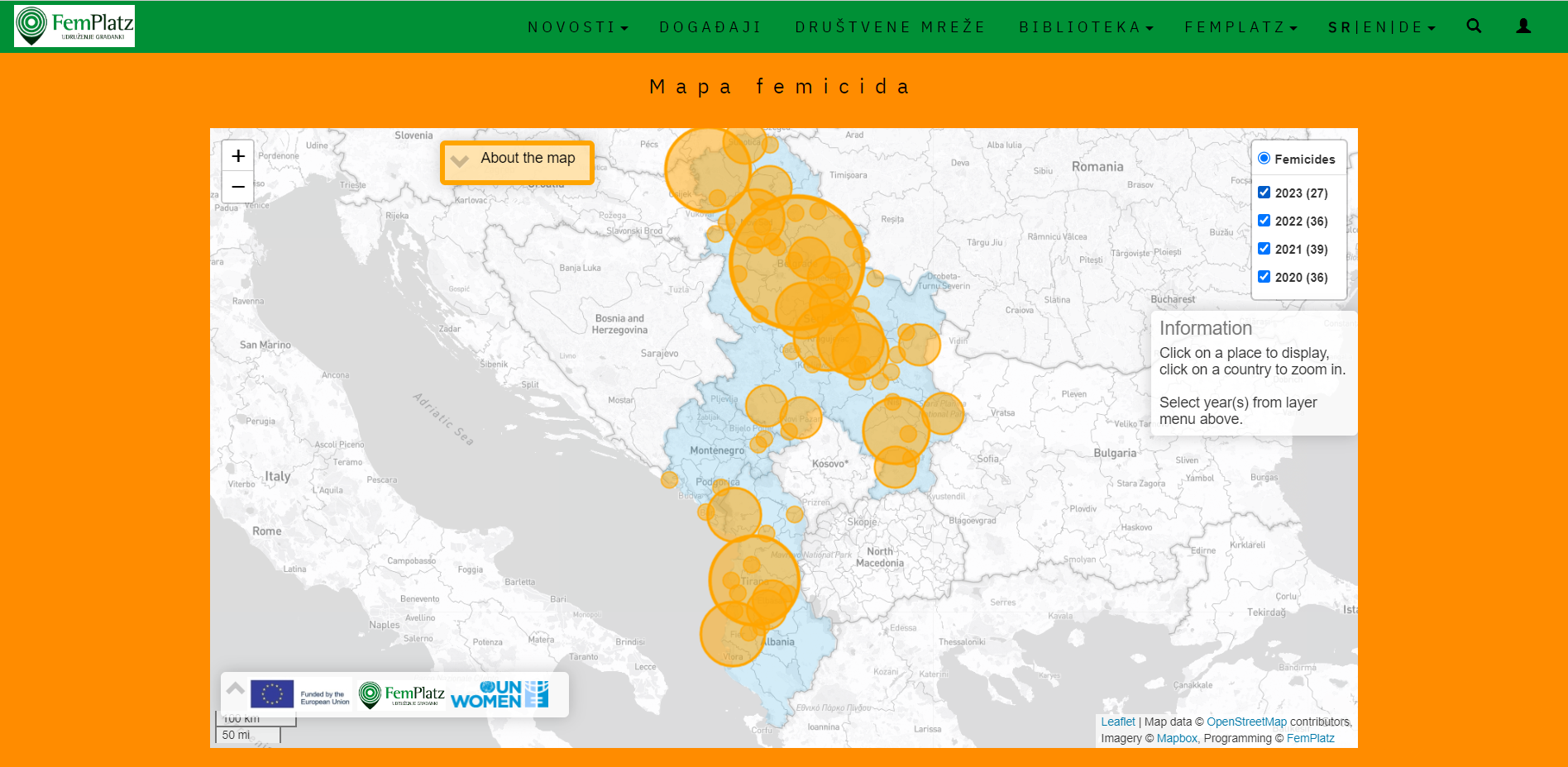It’s hard to decide how to write about this topic. There’s so much to be said about gun violence in Serbia and across the region. I think about it all the time, not only because it’s part of my job, but also because firearms are part of the system I was brought up in; it is an everyday reality that society has normalized possession of and access to guns. And the misuse of firearms draws everything from approval, to disbelief, grief, anger or even a lack of any reaction. It all depends.
I know for a fact that this article would’ve looked different if I’d written it a few months ago, any time before May 3, 2023. I don’t know how — or if at all — anyone could provide any rational explanation about the recent school shooting committed by a 13-year-old boy.
This one didn’t happen in the United States. According to the Washington Post, there have been a total of 380 school shootings in the U.S. since 1999. We know that this is a common occurrence there. We hear about it regularly in the news. However, the recent events in Serbia showed that people in Serbia, the Balkans and across Europe didn’t anticipate a shooting at an elementary school. This gruesome social phenomenon has usually just been associated with the U.S.
The day after the mass murder at the school, another one happened. In a drive-by shooting spree across two villages near Mladenovac, Serbia, a 21-year-old man killed eight people and injured 14 more in Dubona and Malo Orašje. In the elementary school shooting, a total of ten people (eight girls, one boy and a security guard) were killed, while six students were injured.
These weren’t the first mass shootings in Serbia in recent years. Since 2002, there have been seven such cases, five of which were related to domestic violence or intimate partner violence.
We need to examine how we got here. We need to talk about where the perpetrators got their weapons, who taught them to handle firearms and how they came up with this idea to solve their problems by shooting at their peers or random passers-by.
We also need to examine why violence against women — including instances of gun violence or threats of gun violence — elicits a weak institutional response. These two issues are interlinked. They only differ in the societal response.
The Balkan gun cult(ure)
Though some might refer to it as “gun culture,” I see a cult of the gun all across the Balkans. It’s an overlooked phenomenon; we’ve all gotten used to it. Handling an M-48 rifle was a school assignment when I was a kid. We did that in seventh grade. I used to have practical exams in gun assembly and disassembly as well as shooting.
People in the Balkans find all sorts of reasons to shoot their guns: weddings, births (or rather, the births of sons given that we are a patriarchal society), feasts, sporting events and more.
Generations of people who grew up in this region know what I’m talking about. Back then, no one saw a problem with the fact that schoolchildren were exposed to firearms. And these were all graded assignments.
After high school, my generation went off to war. Men, practically still boys, went directly from school benches to the frontlines. The country dissolved, leaving thousands dead in the wake. In the end, many men returned with guns that were used throughout the 1990s; some were bought, while others were inherited. Nevertheless, we were surrounded by firearms. We still are.
People in the Balkans find all sorts of reasons to shoot their guns: weddings, births (or rather, the births of sons given that we are a patriarchal society), feasts, sporting events and more.
In a recent episode of the show “Svadba iz mog kraja” (“Weddings in My Hometown”) on Radio Television Serbia, Serbian viewers were presented with a scene of guests shooting at an apple hung over the house from a long branch. It was portrayed not as a dangerous prohibited act, but as a long-standing tradition. We have a name for this in Serbian: šenlučenje. Coming from Turkish, it means “to express joy and satisfaction (or lack thereof) by means of shooting into the air.”
A few years ago, there was a campaign by SEESAC (The South Eastern and Eastern Europe Clearinghouse for the Control of Small Arms and Light Weapons) titled “Slavi srcem, ne oružjem” (“Celebrate with your heart, not your gun”), which aimed to raise awareness about the dangers of celebratory gunfire, which can lead to injury or death.
This practice largely died out in socialist Yugoslavia. However, in the early 1990s, social unrest, conflicts and the general omnipresence of guns brought about a comeback of šenlučenje. Accidental firearms deaths also rose.
SEESAC reported 125 cases of celebratory shooting across Southeastern Europe in 2021, which constituted an increase from the previous year. Of those 125 cases, 84 occurred during family celebrations, while 77% of the total involved illegal weapons. Celebratory gunfire incidents saw two men killed, with four men and three women injured.
Gun ownership
There’s no official information on the number of legally owned firearms in Serbia. Even after the recent mass murders, the number is only subject to speculation. Latest media reports indicate that around 800,000 firearms are currently registered and owned by 570,000 individuals. According to various studies, Serbia and other countries in the region are world leaders in gun ownership per capita.
In 2017, with 37.8 firearms per 100 residents, Serbia was ranked fifth in the world, right behind the U.S., Yemen, Switzerland and Finland. As for the rest of the Western Balkans, North Macedonia and Montenegro were ranked 20th and 21st respectively.
A more recent study shows that Serbia and Montenegro are countries with the third largest number of firearms per capita (behind the U.S. and Yemen), while Bosnia and Herzegovina, North Macedonia and Kosovo are among the top 25 countries. In 2018, the Serbian Interior Ministry said that the over 920,000 guns currently registered in the country represented a decline in numbers.
One thing we know for sure is that the majority of gun owners are men.
The fact that we don’t have reliable information on legal gun ownership in the region fuels concerns about illegal gun ownership, given that it is also prevalent across the region. However, one thing we know for sure is that the majority of gun owners are men.
One of SEESAC’s surveys showed that the following percentages of total firearms are owned by men: 98.9% in Albania, 98.5% in Bosnia and Herzegovina, 99.4% in Montenegro, 99.9% in Kosovo, 99.5% in North Macedonia and 94.7% in Serbia. Gun ownership is clearly gendered.
Men also cause the majority of celebratory gunfire incidents. Men did the shooting in every single one of such incidents recorded in 2020. The next year, men opened fire in 120 out of 133 celebratory gunfire cases, while women did so in four cases. As for the remaining nine cases, there’s no data on the shooters’ gender. Similarly, men are responsible for the majority of other incidents involving firearms. Violence against women is particularly significant in this respect.
Guns and violence against women
It’s widely known that women are the main victims of domestic violence and gender-based violence and that the perpetrators are mainly men. When it comes to media reporting, violence against women is often subject to sensationalism. Specific instances tend to be referred to as “family tragedies” and victims are blamed as much as perpetrators.
According to an OSCE survey on well-being and safety of women in the Western Balkans, 70% of women have experienced some form of violence, stalking or sexual harassment since the age of 15. Furthermore, 23% of women have experienced physical and/or sexual violence at the hands of an intimate partner, while 18% have experienced it at the hands of someone other than a partner.
Few regional studies have examined the link between gun violence and violence against women, although women’s organizations are now making successful efforts to bring this subject into public discourse.
A UNDP study shows that domestic violence in Serbia is part of the broader dynamic of gender norms and that it is mostly committed by men and targets women. Moreover, according to UNDP, a large number of femicides were not prevented because the institutional response was delayed and inefficient.
The UNDP study also shows that gun violence is gendered as well. While men make up the majority of perpetrators and victims of firearm homicides, women are murdered, injured and/or threatened with firearms much more often within the context of domestic violence and intimate partner violence.
Research shows that men commit these crimes 32 times more often than women, who are murdered five times more often than men in the context of domestic violence.
In Serbia, there are no precise records on domestic violence incidence or the use of guns as a means of intimidation or inflicting lethal harm. However, the widespread availability of guns poses a great threat when it comes to violence against women and is one of the indicators of a high risk of femicide.
This is supported by the fact that nearly one third of total femicides in Serbia were committed with firearms. Research shows that men commit these crimes 32 times more often than women, who are murdered five times more often than men in the context of domestic violence.
Femicide and guns
When there are guns in a household, any domestic violence is much more likely to result in death. Between January and mid-May 2023, 17 femicides were committed in Serbia. Five of them were committed with firearms.
SEESAC’s 2019 regional survey — the first one to collect data on domestic violence-related femicide rates — shows that the most common form of femicide in Southeastern Europe is committed by a family member: 61% of all victims were murdered by a family member. In murder cases with male victims, only 12.4% were killed by a relative.
Women are also being killed by their intimate partners at alarming rates. In the survey, 38.6% of female murder victims were murdered by their partners. For male victims the rate was only 1.2%.
Between 2019 and 2021, SEESAC notes, Southeast European countries recorded a total of 101 gun-related homicides in the context of domestic violence — more than in any other context. More people were murdered in the context of domestic violence than in criminal or other public disputes and undetermined shootings. In this period, 83 women were murdered, 64 of which died by firearm.
The research shows that the most likely way a woman will become a victim of femicide is at the hands of their intimate partner or ex-partner armed with a gun. During this period, 47 out of the 64 women killed by firearms in this region were murdered by their intimate partners or ex-partners. In that same period, two men were killed by partners or ex-partners.
Out of all domestic and intimate partner violence cases involving firearms, 98% were committed by men and 85% were committed with illegal guns.
When discussing gun femicides, we should note that femicides are often followed by the perpetrator’s suicides. Between 2017 and 2020, nearly 80% of men who committed femicide either committed suicide or attempted suicide immediately afterwards.
The latest report by UNDP Serbia indicates that most murder-suicide cases with female victims occur within intimate relationships and the murder is often committed in public.
Some of the most significant factors that contribute to an increased risk of femicide-suicides is access to firearms, including jobs or hobbies that involve guns. In many femicides the male partner demonstrates jealousy and controlling behavior and the female partner may have recently left the relationship or is planning a separation. In the lead-up to the murder, many women are stalked by their partners or are faced with incessant phone calls. In many cases, there was a history of violence in the relationship, including threats of murder or suicide.
One major issue in Serbia and across the region is that information on femicide and gun-related violence against women is not easily accessible and comprehensive data on the issue across borders is not being collected. Over the years, there have been attempts to compile this information by regional women’s organizations.
One new initiative has been created by the Pančevo-based women’s civic association FemPlatz. Their interactive online map contains information on femicide cases in Albania, Montenegro and Serbia dating back to 2020. Descriptions of specific femicide cases include all relevant details taken from media reports, including whether firearms were used and whether the murderer committed or attempted suicide.
The organization plans to expand the tool to include information for other countries across the region.
How does the justice system respond?
A 2021 report shows how the Serbian judicial system deals with domestic violence and the misuse of firearms. In all 28 completed legal cases examined in the report, the perpetrators were men, half of whom had no priors. One of these men was previously convicted of gun misuse, while three others were employed by organizations or institutions that provide access to weapons.
Although the motives of the crimes weren’t determined by the courts, the motives were clear in five of these cases. Three cases were motivated by jealousy, one by a “refusal to divorce” and one by greed.
Nearly half of the cases examined in the report involved a handgun, but some other weapons were used as well, including bombs or hand grenades, automatic weapons, and concealed or silenced firearms (which are not authorized for the public).
Many of these court rulings contain no information on gun licenses, while 11 perpetrators are said to have possessed none. When it comes to the sentences handed down for domestic violence where the perpetrator threatened to use or used a firearm, they are too lenient, considering the overall threat to society.
Neither threats of use nor use of firearms in these crimes influenced the sentences. That is to say, no one received the maximum sentence — the majority of perpetrators were sentenced to one year in prison, or even less than that.
It is productive to quote one of the case studies from the report in full:
"After a divorce hearing the perpetrator threatened the injured party, who was in a state of fear as he had said that he would not allow her to divorce him and that he would sooner kill her than accept the divorce. Bearing all this in mind, the injured party left town; she went to her relatives’ household. The perpetrator located her on the very same day, carrying a Rhöner SM-100 handgun (6.35×15 mm caliber).
As soon as she saw the perpetrator outside, the injured party began to run. He chased after her, pointing the gun at her and shouting: “I will kill you!” The injured party’s parents, uncle and brother managed to intercept him, grabbing his gun; the police arrived soon afterwards. It was determined that the perpetrator did not possess a firearms license and that he was on parole as he had violated a domestic violence-related security measure issued against him.
The perpetrator was sentenced to six months incarceration, but the sentence was to be executed in his residence as electronically monitored house arrest. Even though the verdict references that the perpetrator committed prolonged violence against the injured party, having also been convicted of not respecting domestic violence-related security measures, the court emphasized that the perpetrator owned a private company and that he no longer lived in partnership with the injured party, therefore deciding that he serve the sentence as house arrest. This was done so that his livelihood and company would not be affected."
Gun control
Gun control regulations have been improved across the region in recent years, while a number of studies have been conducted on gender aspects of gun violence. More specifically, the correlation between firearms and violence against women is now firmly established, and SEESAC has spearheaded these efforts. Between 2012 and 2016, SEESAC reported that 37.4% of domestic violence cases involving guns resulted in deaths.
All countries in the Western Balkans have adopted rather strict regulations and compliance is largely satisfactory. However, as is the case with any other regulations, there’s still room for improvement.
Following the two mass murders in Serbia that caused an uproar across the region, a firearms surrender campaign was started under the slogan “Predaj oružje” (“Hand over your weapons”). Within this campaign, people have an opportunity to surrender their weapons with no repercussions — regardless of whether the guns are legally or illegally owned. According to official figures, 36,265 firearms, 9,943 landmines and other explosive weapons and 1,817,190 rounds of ammunition were surrendered by late May.
This is one of the most successful disarmament campaigns ever launched in Serbia. It’s good that the number of firearms is going down, especially considering that the exact number of privately owned guns is unknown.
Yet, many questions remain. Why only now? Why didn’t earlier mass murders elicit such a response? We also need to examine why the institutional and societal response to femicides — including the ones committed with firearms — is timid. As I ask myself all this, I can hear my radio play a popular tune with the following lyrics: “I bought myself a ring/ And a nice rifle, too,/ But only one of these/ Is intended for you.”
Feature image: via CC.



good article, you may have read it Bacio R.